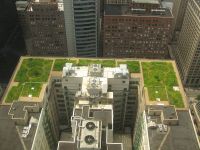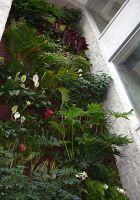 Living Roofs are human-made vegetated areas on the top of buildings that
entail a number of social a environmental benefits.
Living Roofs are human-made vegetated areas on the top of buildings that
entail a number of social a environmental benefits.
Living Roof systems, also called Green Roofs or Sky Gardens, date back to the pre-mediaeval days in Europe when sod roofs in Scandinavia were commonly used to keep country homes warm and dry. In fact it could be claimed that the oldest surviving green roof is on New Grange, county Meath in Ireland.
 Essentially a living wall is a vertically grown plant community which mimics the growth mode of plants
on a natural rock wall. In such situations, a continuous seep of moisture flowing over the surface
supports a varied population of mosses, ferns, and other companion plants.
Essentially a living wall is a vertically grown plant community which mimics the growth mode of plants
on a natural rock wall. In such situations, a continuous seep of moisture flowing over the surface
supports a varied population of mosses, ferns, and other companion plants.
